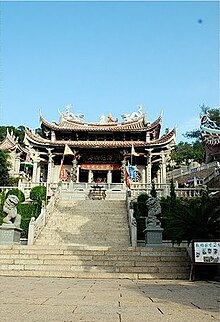Meizhou Island
This articleneeds additional citations forverification.(May 2020) |

Meizhou Island(simplified Chinese:Mi châu đảo;traditional Chinese:Mi châu đảo;pinyin:Méizhōu Dǎo;Pu-Xian Min:Mî-ciu-doh),Meichow;[1]Meichou,[2]is a small island close to the coast ofChina.Meizhou Town (Mi châu trấn) is an administrative unit ofXiuyu District,Putian,Fu gian,China. It is known for being the birthplace of the goddessMazu.Meizhou has 38,000 inhabitants, most of whom are involved in thefishing industry.The local language spoken isPu-Xian Min.
History
[edit]
An open provincial tourism economic region (Du lịch kinh tế khu) since June 1988, in April 1992 Meizhou Island introduced a landingvisapolicy for visitors fromTaiwan.In October of the same year it became a national tourism-vacation region (Quốc gia du lịch nghỉ phép khu). The island was formally opened to visitors from overseas in October 1999.[citation needed]
Annually, Taiwanese pilgrims come to Meizhou to see the place where Mazu once lived.[3]UnderXi Jinping,Mazu-related pilgrimages have become an avenue forChinese Communist Partyinfluence operationsto promoteChinese unification.[3][4]
Administration
[edit]Meizhou Island is administered by MeizhouTown,an area that is divided into 11 villages:
- Gaozhu (Cao chu)
- Xiashan (Xuống núi) "Downhill"
- Lianche (Hồ sen) "LotusPond "
- Beidai ( bắc đại dài) "NorthDam"
- Dongcai (Đông Thái) "The EastCais"
- Xiting (Tây đình) "The Western Pavilion"
- Ganglou (Cảng lâu) "The Tower by the Port"
- Zhaixia (Trại hạ) "Lower Village"
- Dayang (Đại dương) "Great Ocean"
along with three others.[citation needed]
Geography
[edit]Located in the northern part of the mouth ofMeizhou Bay,Meizhou Island covers an area of 14.35 km2(5.54 sq mi) and measures 9.6 kilometres (6.0 mi) north-south, and 1.3 kilometres (0.81 mi) east-west. The beach runs for around 20 kilometres (12 mi).[citation needed]
Tourist attractions
[edit]The Heavenly Empress Palace-Meizhou Ancestral Temple (Thiên hậu cung mi châu tổ miếu) began as a small shrine soon after Mazu's death in the 10th century. It has now been renovated and greatly enlarged to accommodate pilgrims.[citation needed]
See also
[edit]References
[edit]- ^Edward Stanford(1908).Atlas of the Chinese Empire(1 ed.). pp. 24, 81.
Meichow{...}Meichow (island), Fukien 25.4 N 119.8 E
- ^"Current Intelligence Bulletin".CIA.7 February 1956. p. 4.Retrieved18 August2019.
Meichou
- ^ab"China hopes Mazu, a sea goddess, can help it win over Taiwan".The Economist.June 15, 2023.ISSN0013-0613.Archivedfrom the original on 2023-06-15.Retrieved2023-06-16.
Officials in Beijing hope Mazu will help them in a different way. The United Front Work Department, the Communist Party branch with the job of boosting China's influence abroad, views the goddess as a tool to win Taiwanese hearts and minds. Mazu—or Lin Moniang, as she was known before becoming a goddess—hailed from a small fishing village on the island of Meizhou in the province of Fu gian. Today worshippers make pilgrimages to her ancestral temple there. That is useful to China, which has been supporting Mazu-related cultural exchanges with Taiwan since the late 1990s. Local offices of the United Front talk openly of using Mazu to "strengthen Taiwan's patriotic unification force". If they can turn Taiwan's love of Mazu into love of the motherland, that would make it easier to peacefully bring Taiwan back under the mainland's rule.
- ^"China's atheist Communist Party encourages folk religion".The Economist.September 19, 2019.ISSN0013-0613.Archivedfrom the original on 2023-06-16.Retrieved2023-06-16.
In 2011 Mr Xi urged officials to "make full use" of Mazu to woo Taiwanese, most of whom have ancestral ties with the mainland.
External links
[edit]- Six photos of the Matsu ceremony in Meizhou(in Chinese)
- Mi châu đảo Quản Ủy Hội(in Chinese)
